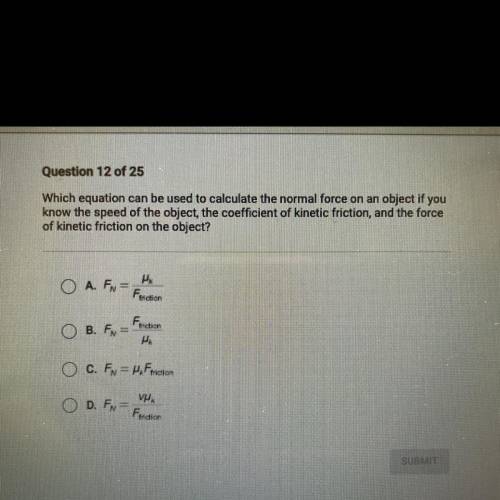
Physics, 22.01.2021 20:20 gabrielgutierrez730
Which equation can be used to calculate the normal force on an object if you
know the speed of the object, the coefficient of kinetic friction, and the force
of kinetic friction on the object?


Answers: 1


Another question on Physics

Physics, 21.06.2019 18:10
Keneila is attempting to ski down a 20 m high friction free hill for the first time. she has a speed 10 m/s at the top. what is her kinetic energy when she is a the bottom, 20 m ? (a)2500 j (b)9800 j (c)12300 j (d)3100j (e)15000j
Answers: 2

Physics, 22.06.2019 02:40
What happens when chlorine reacts with bromine? a. electrons move from the chlorine atoms to the bromine atoms. b. electrons move from the bromine atoms to the chlorine atoms. c. electrons are shared between the chlorine atoms and the bromine atoms. d. electrons become delocalized among the atoms.
Answers: 2

Physics, 22.06.2019 16:30
In a heat engine if 1000 j of heat enters the system and the piston does 500j of work, what is the final internal energy of the system if the inital energy was 2000 j1.write the equation2.list out your known variables 3. plug the numbers into the equations4.solve 5.write your solution statement that includes initial energy and final energy added.
Answers: 3

Physics, 22.06.2019 17:00
In the future, people will only enjoy one sport: electrodisc. in this sport, you gain points when you cause metallic discs hovering on a field to exchange charge. you are an electrodisc player playing the popular four disc variant. the disks have charges of qa = −8.0 µc, qb = −2.0 µc, qc = +5.0 µc, and qd = +12.0 µc. (1) you bring two disks together and then separate them. you measure the resulting charge of these two disks and find that it is +5.0 µc per disk. which two disks did you bring together? (a) a and b (b) a and c (c)a and d (d)b and c(e) b and d (f) c and d. (2) you bring three disks together and then separate them. you measure the resulting charge of these three disks and find that it is +3.0 µc per disk. which three disks did you bring together? a, b, and c (a) a, b, and d (c) a, c, and d (d) b, c, and d. (3) given the resulting charge of each disk measured in (b) is +3.0 µc, how many electrons would you need to add to a disk of this charge to electrically neutralize it? electrons
Answers: 3
You know the right answer?
Which equation can be used to calculate the normal force on an object if you
know the speed of the...
Questions


Mathematics, 16.12.2020 22:40

English, 16.12.2020 22:40

Chemistry, 16.12.2020 22:40




Mathematics, 16.12.2020 22:40

Mathematics, 16.12.2020 22:40


Computers and Technology, 16.12.2020 22:40

Mathematics, 16.12.2020 22:40

Mathematics, 16.12.2020 22:40


Mathematics, 16.12.2020 22:40


Mathematics, 16.12.2020 22:40


Biology, 16.12.2020 22:40

History, 16.12.2020 22:40



